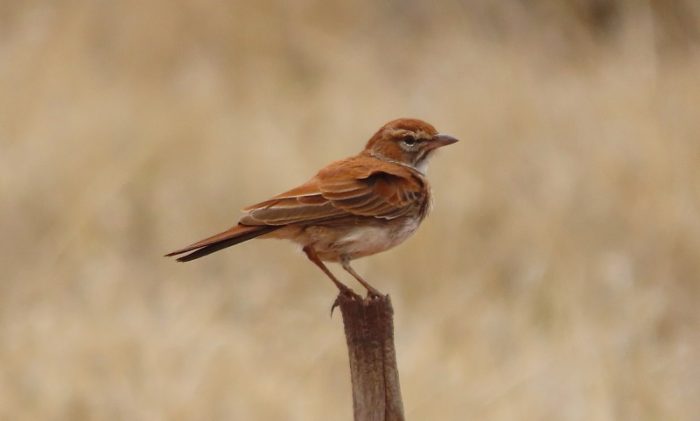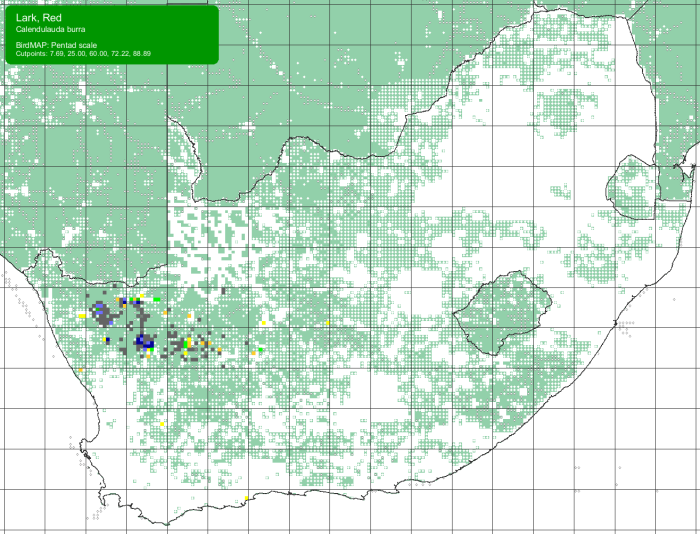Cover image: Red Lark by Phillip Nieuwoudt – Near Aggeneys, Northern Cape – BirdPix No. 73871
Identification
The Red Lark is a large, handsome species with a more robust build than other similar larks. The beak is relatively short but stout. The facial markings are bold. The supercilium and the line under the eye form a broad white eye-ring with a black stripe through the middle. The black malar stripe is broad and conspicuous. Upperpart colouration is variable and ranges from brick red to orange-red to dull brown with darker streaks. Populations are known to intergrade but typically birds from dune habitats carry the red colour while those from the plains are brown above. The underparts are white and the breast is heavily streaked in black. The flanks are usually un-marked and the tail is relatively long and heavy.

Photo by J. Terblanche
The sexes differ in that the male is larger and has a heavier, more robust beak.
Juveniles show more brightly coloured upperparts and the feathers on the back, mantle and crown have pale tips.
The red Lark is similar to the closely related Karoo Lark (Certhilauda albescens) but is larger, has a heavier beak and normally has un-streaked flanks. The two species also have minimal range overlap and favour different habitats.

Photo by Ryan Tippett
Status and Distribution
The Red lark is considered uncommon and is endemic to South Africa. Its distribution is confined to the Northern Cape Province, largely within the region known as Bushmanland. It is found from between Carnarvon and Vanwyksvlei in the east to the Koa river valley near Steinkopf in the west. The Red Lark is localised within its distribution due to its specific habitat requirements.

Photo by Zenobia van Dyk
It is believed that the distribution and numbers may have been reduced, but atlas records, particularly in the eastern parts of its range, suggest that it could be more common and widespread than previously thought.

Details for map interpretation can be found here.
Habitat
The Red Lark inhabits rolling, red sand dunes and sandy flats with an abundance of tussocked grass and scattered taller shrubs to perch on. An important requirement of its habitat is large-seeded grasses such as Brachiaria glomerata for food, and perrenial grasses with plumed awns, such as Stipagrostis ciliata for nest material and nest sites. It favours places with bare substrate between grass tussocks or shrubs and avoids spots with dense grass cover. Brown plains form birds are found between the dune systems on sands, shales or clay flats, provided large seeded grasses are present.

Vanwyksvlei district , Northern Cape
Photo by Ryan Tippett
Behaviour
Not much is known about the ecology of the Red Lark. It is a sedentary, resident species but may move locally according to environmental conditions.
They are found either solitarily or in pairs. When flushed they fly to the next dune or shrub patch and avoid landing in dense grass. They often run some distance from where they landed. Frequently perches on shrubs or trees, especially on dune crests. Often perches horizontally with legs extended and the tail pointing to the ground at an angle. Seeks shelter under shrubs during the midday heat.

Near Aggeneys, Northern Cape
Photo by John Cox
Forages on the ground at the base of plants . They feed primarily on large grass seeds but also seeds and berries from various forbs and shrubs. The diet additionally includes a wide range of invertebrates including beetles, ants, termites, mantids, spiders and ticks etc.
Males display at the start of the breeding season. Red Larks breed opportunistically during favourable conditions anytime between August and May, but most breeding happens during October. In display, the male flies up from a perch to around 20m, fluttering and hovering against the wind. The tail is usually fanned and held downwards. He then circles with slow wing-beats, singing, then descends in a dipping dive to land on a perch or on the ground. He may continue to call from a perch with the tail fanned.
The Red lark is monogamous and is a territorial, solitary nester. The nest is a domed cup of coarse grass, built into a scrape between grass tussocks. 2 or 3 eggs are laid per clutch, however, the incubation, nestling and fledging period is unrecorded. The young are known to be fed by both sexes.

Photo by Phillip Nieuwoudt
Further Resources
Species text adapted from the first Southern African Bird Atlas Project (SABAP1), 1997.
The use of photographs by Alan Collett, J Terblanche, John Cox, Phillip Nieuwoudt and Zenobia van Dyk is acknowledged.
Virtual Museum (BirdPix > Search VM > By Scientific or Common Name).
Other common names: Calendulauda burra (Alternative Scientific Name); Rooilewerik (Afrikaans); Alouette ferrugineuse (French); Oranjelerchee (German); Cotovia-vermelha (Portuguese)
A list of bird species in this format is available here.
Recommended citation format: Tippett RM 2023. Red Lark (Certhilauda burra) Biodiversity and Development Institute. Available online at http://thebdi.org/2023/02/16/red-lark-certhilauda-burra/

Photo by Alan Collett

